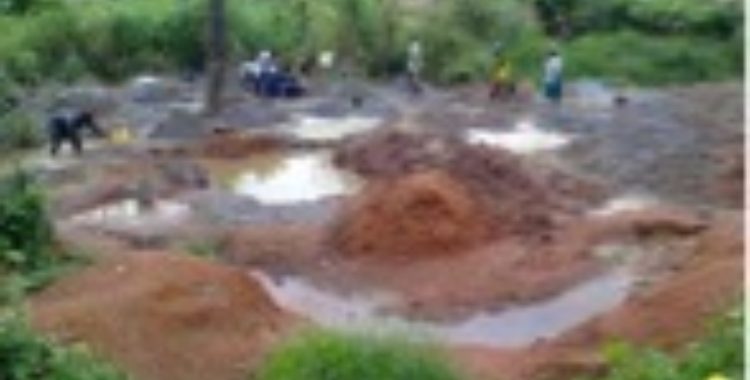The artisanal mining pits are generally empty, and the miners are tuned to the BBC for European football match results. In the face of Ebola, some youths in the Kono District of Sierra Leone have braved the disease to continue mining in very small manageable groups. But most have had to turn elsewhere, and we find a large percentage of youths have actually turned to betting on football matches in Europe and other parts of the world. A far cry from the usual state of affairs in Kono, where the focus is usually on teams of diggers, not teams of international football players.
Since the discovery of diamonds in Sierra Leone and the subsequent start of mining in the 1930s, the Kono District in general and Koidu City in particular have been identified with the precious stones. Mining, especially of diamonds and gold, is a way of life for many inhabitants of Kono, although it should be known that in reality only 6 out of 14 chiefdoms in the district have actually been proven to contain economically viable deposits of diamonds. The rest of the Kono people are traditionally farmers of cereal crops (rice, sorghum, millet), tree crops (Cacao, coffee, kola nut, palm plants), vegetables and other perennial crops.
As you may imagine, Kono’s wealth of natural resources has placed it at the heart of national politics, especially during national elections and socio-economic turmoil. The desire to gain control of its natural resources turned the district into a political battle-ground during the 1970s and 80s, and the battle ground for all the warring factions during the civil war between 1991-2002.
But unlike other crises in the past, Kono has not been one of the declared epicenters of the Ebola crisis by Government of Sierra Leone - yet. Since the outbreak of the disease in May, the first confirmed positive case in Kono was only registered in July and, to date, there have been just over 30 confirmed cases in the entire district, yet other districts are already above 500 confirmed cases.
However, these figures are no guarantee that the district, or the diamond mining sector, is not seriously affected by the outbreak.
If you have ever been to an artisanal mining zone or seen pictures, you know that mining in this type of area generally depends on groups of able-bodied youths coming together to organize their labour in teams to produce more than they would on their own. But with a ban now placed on all gatherings of people throughout the country, artisanal mining has virtually stopped. And as a result, the many other related economic activities, including diamond dealing, the transport sector (commercial bikes and motor vehicles), petty trading and the general circulation of cash in the local economy are terribly affected and all but halted. So even where the disease itself has not yet directly stricken many locals, the extreme measures needed to prevent its spread still take their toll with impoverishment and thus reduced ability to cope with shocks and traumas the inevitable outcomes.
In the past, the country could rely on intra-regional diamond trade to get through a local crisis, but that is also not possible now as the other diamond producing countries in the region are similarly affected. And whilst the Diamond Dealers Association, normally a very prominent local organization, has been instrumental in the past in supporting educational programmes in the district -- by providing scholarships for school-age children, schools with learning and teaching materials, educational efforts focused on girls -- the organization has been noticeably dormant in terms of taking concrete action during the Ebola crisis.
Some members of the Diamond Dealers Association have individually contributed to the response or continued their traditional role of supporting some smaller groups of miners in the fields, but no such community action has been undertaken by the association as a body. A member of the organization told me that the source of funds for these programs they had been using in the past in the district was the revenue from the diamonds they were able to sell. Without diamond production from the artisanal miners, there are no funds.
With the pits quiet and the Association’s resources limited, there is a need for support from the rest of the diamond industry. In the meantime, too many of the local miners will be waiting to see the results from this week’s fixtures in the Premier League.



